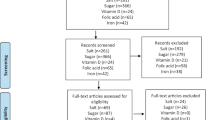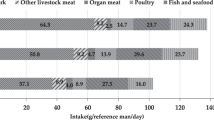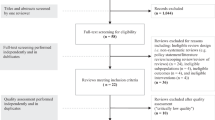Abstract
Malnutrition among older adults causes health problems and economic costs. Prevention of malnutrition through meal service can reduce such costs. This study estimates potential health economic benefits to be generated through meal service to home-dwelling older adults. The study contains three components: (1) systems analysis describing the relationship between meal service, nutritional status, health risk, and health-related costs, focusing on older adults, (2) a series of literature reviews to quantify the identified elements in each stage-subject combination: (i) meal service impact on nutrition status of older adults, (ii) associations between nutrition status and health risks, (iii) health care resource needs associated with these health risks, and (3) a model synthesis of literature findings to estimate the expected economic benefit of improved health status derived from meal service enrollment, using Denmark as an example. Expected economic benefits in terms of saved direct and indirect health care costs and improved quality-of-life was estimated at an amount of €307 per year per individual enrolled, of which direct health care cost savings constituted €75, while value of improved quality-of-life and reduced mortality constituted the rest. The average health economic benefit from enrolling older adults into meal service is likely to decrease with the number of subscribers. Findings like these are important to take into consideration, when making policy decisions regarding size of the meal service capacity, although it should be noted that the presented estimates are based on a number of assumptions of which some are subject to uncertainty.
This is a preview of subscription content, access via your institution
Access options
Subscribe to this journal
Receive 12 print issues and online access
$259.00 per year
only $21.58 per issue
Buy this article
- Purchase on Springer Link
- Instant access to full article PDF
Prices may be subject to local taxes which are calculated during checkout


Similar content being viewed by others
References
Saka B, Kaya O, Ozturk GB, Erten N, Karan MA. Malnutrition in the elderly and its relationship with other geriatric syndromes. Clin Nutr 2010;29:745–8.
Kvamme JM, Holmen J, Wilsgaard T, Florholmen J, Midthjell K, Jacobsen BK. Body mass index and mortality in elderly men and women: the Tromso and HUNT studies. J Epidemiol Community Health 2012;6:611–7.
Wu CY, Chou YC, Huang N, Chou YJ, Hu HY, Li CP. Association of body mass index with all-cause and cardiovascular disease mortality in the elderly. PLoS One 2014;9:e102589.
Gariballa SE, Sinclair AJ. Nutrition, ageing and ill health. Br J Nutr 1998;80:7–23.
Campbell AD, Godfryd A, Buys DR, Locher JL. Does participation in home-delivered meals programs improve outcomes for older adults? results of a systematic review. J Nutr Gerontol Geriatr 2015;34:124–67.
Sahyoun NR, Vaudin A. Home-delivered meals and nutrition status among older adults. Nutr Clin Pract 2014;29:459–65.
Zhou X, Perez-Cueto FJA, Santos QD, Monteleone E, Giboreau A, Appleton KM, et al. A systematic review of behavioural interventions promoting healthy eating among older people. Nutrient 2018;10:128 https://doi.org/10.3390/nu10020128
Arla & Kost- og Ernæringsforbundet. Underernæring—det skjulte samfundsproblem (Undernourishment—the hidden societal problem), 2014 https://www.kost.dk/sites/default/files/uploads/public/underernaering_publikationsmallpdf.com.pdf. Accessed 27 Nov 2019.
Makai P, Brouwer WBF, Koopmanschap MA, Stolk EA, Nieboer AP. Quality of life instruments for economic evaluations in health and social care for older people: a systematic review. Soc Sci Med 2014;102:83–93.
Yang F, Dawes P, Leroi I, Gannon B. Measurement tools of resource use and quality of life in clinical trials for dementia or cognitive impairment interventions: a systematically conducted narrative review. Int J Geriatr Psychiatry 2018;33:E166–76.
Li L, Nguyen KH, Comans T, Scuffham P. Utility-based instruments for people with dementia: a systematic review and meta-regression analysis. Value Health 2018;21:471–81.
Bulamu NB, Kaambwa B, Ratcliffe J. A systematic review of instruments for measuring outcomes in economic evaluation within aged care. Health Qual Life Outcomes 2015;13:179.
Wittrup-Jensen KU, Lauridsen JT, Pedersen KM. Modelling Danish EuroQol (EQ-5D) Tariffs by Applying the Time Trade-Off Method. University of Southern Denmark, Health Economics Papers 2008:4, https://pdfs.semanticscholar.org/3d7e/4ff89e8cb0f393414295a7a4bfb812ad3534.pdf Accessed Mar 2020.
Roy MA, Payette H. Meals-on-wheels improves energy and nutrient intake in a frail free-living elderly population. J Nutr Health Aging 2006;10:554–60.
Lassen KO, Kruse F, Bjerrum M. Nutritional care of Danish medical inpatients—patients’ perspectives. Scand J Caring Sci 2005;19:258–67.
Charlton KE. Eating well: ageing gracefully! Asia Pac J Clin Nutr 2002;11:S607–17.
Keller HH. Meal programs improve nutritional risk: a longitudinal analysis of community-living seniors. J Am Dietetic Assoc 2006;106:1042–8.
Wright L, Vance L, Sudduth C, Epps JB. The impact of a home-delivered meal program on nutritional risk, dietary intake, food security, loneliness, and social well-being. J Nutr Gerontol Geriatr 2015;34:218–27.
An R. Association of home-delivered meals on daily energy and nutrient intakes: findings from the national health and nutrition examination surveys. J Nutr Gerontol Geriatr 2015;34:263–7.
Lorenzo-Lopez L, Maseda A, de Iabra C, Regueiro-Folgueria L, Rodriguez-Villamil JL, Milan-Calenti JC. Nutritional determinants of frailty in older adults: a systematic review, BMC Geriatrics 2017;17.
Artaza-Artabe I, Saez-Lopez P, Sanchez-Hernandez N, Fernandez-Gutierrez N, Malafarina V. The relationship between nutrition and frailty: Effects of protein intake, nutritional supplementation, vitamin D and exercise on muscle metabolism in the elderly. A systematic review. Maturitas 2016;93:89–99.
Stephen A, Avenell A. A systematic review of multivitamin and multimineral supplementation for infection. J Hum Nutr Dietetics. 2006;19:179–90.
Iolascon G, Gimigliano R, Bianco M, De Sire A, Moretti A, Giusti A, et al. Are dietary supplements and nutraceuticals effective for musculoskeletal health and cognitive function? A scoping review. J Nutr, Health Aging 2017;21:527–38.
Barnes JL, Tian M, Edens NK, Morris MC. Consideration of nutrient levels in studies of cognitive decline. Nutr Rev 2014;72:707–19.
Del Parigi A, Panza F, Capurso C, Solfrizzi V. Nutritional factors, cognitive decline, and dementia. Brain Res Bull 2006;69:1–19.
Dangour AD, Sibson VL, Fletcher AE. Micronutrient supplementation in later life: Limited evidence for benefit. J Gerontol Ser A Biol Sci Med Sci 2004;20:659–73.
Mitchell BL, Ulrich CM, McTiernan A. Supplementation with vitamins or minerals and immune function: can the elderly benefit? Nutr Res 2003;23:1117–39.
High KP. Nutritional strategies to boost immunity and prevent infection in elderly individuals. Clin Infect Dis 2001;33:1892– 900.
Calvaresi E, Bryan J. B vitamins, cognition, and aging: a review. J Gerontol Ser B Psychol Sci Soc Sci 2001;56:327–39.
Church J, Goodall S, Norman R, Haas M. An economic evaluation of community and residential aged care falls prevention strategies in NSW. NSW Public Health Bull. 2011;22:60–8.
Milaneschi Y, Tanaka T, Ferrucci L. Nutritional determinants of mobility. Curr Opin Clin Nutr Metab care 2010;13:625–9. https://doi.org/10.1097/MCO.0b013e32833e337d
Gillette-Guyonnet S, Abellan van Kan G, Andrieu S, Barberger-Gateau P, Berr C, Bennefoy M, et al. IANA Task force on nutrition and cognitive decline with aging. J Nutr, Health Aging 2007;11:132–52.
Rizzoli R, Ammann P, Chevalley T, Bonjour JP. Protein intake and bone disorders in the elderly. Jt Bone Spine 2001;68:383–92.
Heinrich S, Rapp K, Rissmann U, Becker C, Koenig K-H. Cost of falls in old age: a systematic review. Osteoporos Int 2010;21:891–902.
Davis JC, Robertson MC, Ashe MC, Liu-Ambrose T, Khan KM, Marra CA. International comparison of cost of falls in older adults living in the community: a systematic review. Osteoporos Int 2010;21:1295–306.
Takizawa C, Thompson PL, van Walsem A, Faure C, Maier WC. Epidemiological and economic burden of Alzheimer’s disease: a systematic literature review of data across Europe and the United States of America. J Alzheimer’s Dis 2015;43:1271–84.
Mauskopf J, Racketa J, Sherill E. Alzheimer’s disease: the strength of association of costs with different measures of disease severity. J Nutr, Health Ageing. 2010;14:655–63.
Jönsson L, Wimo A. The cost of dementia in Europe: a review of the evidence, and methodological considerations. Pharmacoeconomics 2009;27:391–403.
Leung GM, Yeung RYT, Chi I, Chu LW. The economics of Alzheimer disease. Dement Geriatr Cogn Disord 2003;15:34–43.
SBU. Dementia-caring, ethics, ethnical and economical aspects: a systematic review, Stockholm: Swedish Council on Health Technology Assessment; 2008
Rice DP, Fillit HM, Max W, Knopman DS, Lloyd JR, Dattagupta S. Prevalence, costs, and treatment of Alzheimer’s disease and related dementia: a managed care perspective. Am J Managed Care 2001;7:809–18.
Danish Economic Council. Økonomi og Miljø 2016 (Economy and the Environment). De Økonomiske Råd. 2015, https://dors.dk/files/media/rapporter/2016/M16/M16_med_rettelse.pdf, Accessed Nov 2017.
Gyrd-Hansen D. Willingness to pay for a QALY. Health Econ 2003;12:1049–60.
Gyrd-Hansen D, Kjær T, Nielsen JS. The value of mortality risk reductions: pure altruism—a confounder? J Health Econ 2016;49:184–92.
Goncalves-Bradley DC, Lannin HA, Clemson LM, Cameron ID, Shepperd S. Discharge planning from hospital, Cochrane Database Syst Rev. 2016;1:1–87
Castaneda-Orjuela C, Alvis-Guzman N, Jose Paternina A, De la Hoz-Restrepo F. Cost-effectiveness of the introduction of the pneumococcal polysaccharide vaccine in elderly Colombian population. Vaccine. 2011;29:7644–50.
Burch J, Paulden M, Conti S, Stock C, Corbett M, Welton NJ, et al. Antiviral drugs for the treatment of influenza: a systematic review and economic evaluation. Health Technol Assess. 2009;13:1–265.
Snooks HA, Anthony R, Chatters R, Dale J, Fothergill R, Gaze S, et al. Support and Assessment for Fall Emergency Referrals (SAFER) 2: a cluster randomised trial and systematic review of clinical effectiveness and cost-effectiveness of new protocols for emergency ambulance paramedics to assess older people following a fall with referral to community-based care when appropriate. Health Technol Assess 2017;21:1–298.
Church JL, Haas MR, Goodall S. The cost effectiveness of falls and injury prevention strategies for Older Adults Living in Residential Aged Care Facilities. Pharmacoeconomics 2015;33:1301–10.
Haines TP, Nitz J, Grieve J, Barker A, Moore K, Hill K, et al. Cost per fall: a potentially misleading indicator of burden of disease in health and residential care settings. J Evaluation Clin Pract 2013;19:153–61.
Cotter PE, Timmons S, O’Connor M, Twomey C, O’Mahoney D. The financial implications of falls in older people for an acute hospital. Ir J Med Sci 2006;175:11–13.
Pedersen A, Christensen T, Matthiessen J, Knudsen VK, Rosenlund-Sørensen M, Biltoft-Jensen A, et al. Danskernes kostvaner 2011–2013 (Dietary habits in Denmark 2011–2013), DTU National Food Institute. 2015
Flachs EM, Eriksen L, Koch MB, Ryd JT, Dibba E, Skov-Ettrup L, et al. Sygdomsbyrden i Danmark – sygdomme. Statens Institut for Folkesundhed, Syddansk Universitet, København: Sundhedsstyrelsen; 2015.
Christensen T, Jensen JD Beregning af de samfundsøkonomiske omkostninger ved sygdomstilfælde forårsaget af Salmonella, Campylobacter, Listeria og VTEC (Assessment of the welfare economic costs of diseases caused by Salmonella, Campylobacter, Listeria and VTEC), Institut for Fødevare- og Ressourceøkonomi, Københavns Universitet. IFRO Rapport, Nr. 262. 2017
Statistics Denmark databank www.statbank.dk. Accessed Apr 2019.
Taylor AH, Cable NT, Faulkner G, Hilsdon M, Narici M, Van Der Bij AK. Physical activity and older adults: a review of health benefits and the effectiveness of interventions. J Sports Sci 2004;22:703–25.
Williamson S, Landeiro F, McConnell T, Fulford-Smith L, Javaid MK, Judge A, et al. Costs of fragility hip fractures globally: a systematic review and meta-regression analysis. Osteoporos Int 2017;28:2791–800.
Cooper NJ. Economic burden of rheumatoid arthritis: a systematic review. Rheumatology 2000;39:28–33.
Leedo E, Gade J, Granov S, Mellemgaard A, Klausen TW, Rask K, et al. The effect of a home delivery meal service of energy- and protein-rich meals on quality of life in malnourished outpatients suffering from lung cancer: a randomized controlled trial. Nutr Cancer 2007;69:444–53.
Ruxton CHS, Derbyshire E, Toribio-Mateas M. Role of fatty acids and micronutrients in healthy ageing: a systematic review of randomised controlled trials set in the context of European dietary surveys of older adults. J Hum Nutr Dietetics 2016;29:308–24.
Dror Y, Stern F, Gomori MJ. Vitamins in the prevention or delay of cognitive disability of aging. Curr Aging Sci 2014;7:187–213.
Nieves JW. Osteoporosis: the role of micronutrients. Am J Clin Nutr 2005;81:1232S–9S.
Nordberg G, Wimo A, Jönsson L, Kåreholt I, Sjölund BM, Lagergren M, et al. Time use and costs of institutionalised elderly persons with or without dementia: results from the Nordanstig cohort in the Kungsholmen Project–a population based study in Sweden. Int J Geriatr Psychiatry 2007;22:639–48.
Hurd MD, Martorell P, Delavande A, Mullen KJ, Langa KM. Monetary Costs of Dementia in the United States. N. Engl J Med 2013;368:1326–34.
Acknowledgements
The study is part of the ELDORADO project ‘Preventing malnourishment and promoting well-being in the elderly at home through personalized cost-effective food and meal supply’ supported by grant (4105-00009B) from the Innovation Fund Denmark.
Author information
Authors and Affiliations
Corresponding author
Ethics declarations
Conflict of interest
The author declares no conflict of interest.
Additional information
Publisher’s note Springer Nature remains neutral with regard to jurisdictional claims in published maps and institutional affiliations.
Rights and permissions
About this article
Cite this article
Jensen, J.D. Health economic benefits from optimized meal services to older adults—a literature-based synthesis. Eur J Clin Nutr 75, 26–37 (2021). https://doi.org/10.1038/s41430-020-00700-9
Received:
Revised:
Accepted:
Published:
Issue Date:
DOI: https://doi.org/10.1038/s41430-020-00700-9



